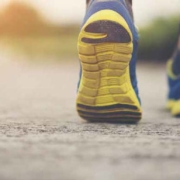How do you walk?

by Paula Allia PT, DHSc, MTC, OCS
Walking is an everyday form of locomotion to get a person from one point to another. It is also something that most take for granted, that is, until there is a problem.
Have you ever observed people as they are walking? Take a look around you at the various gaits. Do they walk straight? Is there a limp of some sort? Is there a side-to-side waddle whether it be small or big?
Walking is taken for granted for the most part until something happens to alter the ability to walk normally. Even if some have a temporary orthopedic problem that alters the gait, some never get back to their own normal. They do not recognize that perhaps the new limp becomes ingrained in the mind and it becomes the newnormal.
Abnormal gait puts wear and tear on all of the surrounding joints. Many times, another joint has to accommodate or take the load to decrease pressures on an injured or arthritic joint. This changes the compressive loads placed on the body. If not corrected this change in load bearing can lead to further issues elsewhere in the body such as a joint. Also, increased loads can be placed on other muscles leading to overuse or abnormal strain.
The body is an amazing machine with its parts aligned in such a way as to accommodate all of the things thrown at it each day. If, however, someone has a hyperextending knee, a pronated (low arch) foot, or a leg length discrepancy, when the foot strikes the ground, there must be a compensatory gait for the faults that are present.
In addition to joint structure anomalies, muscular overload or weakness can be present. These weaknesses may cause a shift in anormal gait pattern, so more stress is indeed placed on the muscles and joints Involved.
Normal gait pattern is heel to toe with a timely use of muscles to keep the body mostly in an erect position with weight shifting and joints bending or straightening depending upon where one is in the gait cycle. It takes muscles to propel and control muscles moving forward and back while other stabilizing muscles control the sway from side to side. Keeping the muscles strong and firing timely in all planes of the body are essential to take care of joint integrity over time.
Observe the limping person. Gait patterns are altered to minimize stress and strain. A compensated movement pattern then becomes used and can be ingrained in the brain.
A limp is usually due to pain or a leg length discrepancy. If there is a discrepancy, the longer leg could accommodate by keeping the knee flexed on the longer leg. Anything over 1/4 inch is considered significant. The whole lower extremity up into the pelvis and back has to accommodate a leg length problem. If you had an injury in the foot and were placed in a temporary boot, even the back may rotate differently and scoliosis can develop temporarily. If it is for a short time, the body will usually go back to its normal movement. If, however, the boot is worn for an extended period of time, the scoliosis can become more permanent if not addressed.
A pronated foot where the arch is lower on one side causes the leg to shorten. This pronated foot causes the leg to turn in and invites more strain on the knee and hip. Wearing appropriate shoes for your foot if there is an arch problem is very beneficial in order to give you the support to walk appropriately and use the proper muscles to do so. Shoes with good arches help to support the joints in their position so that muscles and ligaments do not have to overwork.
Many people buy shoes based on color and style versus comfort and support. Protecting the foot is essential long term. Many have knee, hip or back issues in their lifetime. Keeping muscles strong and coordinated, using them in everyday activities at the very least, help to maintain muscle coordination and muscle memory.
If you need help getting to a better place, please call Fitness Together at (239) 263-9348 (335 14th Avenue South) and we can guide you in the right direction.



Leave a Reply
Want to join the discussion?Feel free to contribute!